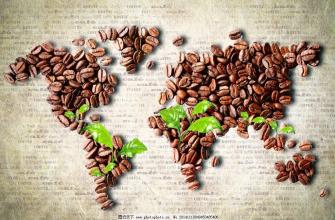Description of Taste and Flavor of Deep-roasted Coffee introduction of Regional treatment method for Variety characteristics
Description of Taste and Flavor of Deep-roasted Coffee introduction of Regional treatment method for Variety characteristics
For many baristas, coffee beans are an unchangeable factor, because many baristas work hard to make coffee in an environment surrounded by commercial beans, so they can't make very good coffee no matter how hard they try. As the old saying goes, "A clever housewife cannot make bricks without rice" is a description of such baristas. As long as the quality of beans is improved, they all belong to the scope of technical control, so coffee beans have nothing to say. You may not make good coffee with good beans, but you can't make good coffee with bad beans. At the same time, we also talk about some mistakes in making hand-brewed coffee. There are all kinds of bean grinders on the market, and a good bean grinder can ensure that the coffee powder is evenly ground. If the coffee powder is uneven and the fine powder is too much, it will make the coffee taste not "pure". What is the suitable thickness of hand-brewed coffee beans? The answer is: moderate grinding, the size of granulated sugar. If the coffee powder is too thick and the hot water flows too fast, it is difficult to extract the aromatic substances from the coffee. If the coffee powder is too fine, the filter is easy to clog, resulting in water and powder soaking for too long, coffee will appear bitter, astringent taste
In addition to the labeling related to the place of origin, the most common is the marking of baking degree. Raw coffee beans need to go through the roasting process to release their unique charming aroma, and the roasting of coffee is closely related to its flavor. If you see "Italy", "Vienna", "Nanyi" and other signs on the coffee label, do not mistakenly think that the coffee beans have anything to do with the above place names-probably not, because traditionally, "Italy" and "Vienna" are synonymous with the degree of roasting (or blending) and do not mean that they are made in Italy or Vienna (as mentioned above). Coffee beans are not grown and produced in Europe. "North Italy" represents the baking of light, light brown beans without oil; "South Italy" refers to the deep baking of bright oil and dark brown on the bean surface; and "Italian baking" generally refers to deeper baking. "French baking (FrenchRoast)" generally refers to the extremely deep baking with a near-black color, slightly coke flavor and no acid. "Vienna" usually refers to a mixture of coffee beans with different degrees of roasting.
The deeper the degree of baking, the higher the temperature of the roasting. The medium-shallow "Northern Italy" baking flavor is more complex and bright, with fruit-like acidity, with little or no bitterness. Deep high temperature baking "Nanyi" baking flavor is low, full-bodied and smooth, with a caramel-like sweet finish. "French baking" has a monotonous flavor, but with a slightly coke flavor and no acid at all.

Important Notice :
前街咖啡 FrontStreet Coffee has moved to new addredd:
FrontStreet Coffee Address: 315,Donghua East Road,GuangZhou
Tel:020 38364473
- Prev

Flannel hand-made coffee step diagram-coffee hook step diagram
Flannel hand coffee step diagram-coffee hook step diagram drip method, as the name implies, is to brew in the form of dripping water. Just like the hourglass, dripping bit by bit into the coffee powder, it is completely delicate and time-consuming! First, the coffee powder is pre-soaked and moistened with a little bit of water, and when it drips about 1 stroke 3, you can start to inject water, when the water level of the coffee powder reaches its peak.
- Next

The steps of fine roasting coffee beans Technical degree Taste introduction
The steps of roasting coffee beans are summarized as stewing below 30, and adjusting according to the exhaust gas volume above 30. An important indicator of exhaust gas volume is the comparison between the speed of exhaust gas temperature rise and the speed of bean temperature rise. A general rule is that the exhaust temperature rises faster than the bean temperature, the bean taste will be clean but the flavor will be weak, the exhaust temperature rises faster than the bean temperature.
Related
- What brand of black coffee is the most authentic and delicious? what are the characteristics of the flavor of the authentic Rose Summer Black Coffee?
- Introduction to the principle and characteristics of the correct use of mocha pot A detailed course of mocha pot brewing coffee is described in five steps.
- Which is better, decaf or regular coffee? how is decaf made?
- How much is a bag of four cat coffee?
- How about four Cat Coffee or Nestle Coffee? why is it a cheap scam?
- Which is better, Yunnan four Cats Coffee or Nestle Coffee? How about cat coffee? is it a fake scam? why is it so cheap?
- How about Cat Coffee? what grade is a hoax? which instant coffee tastes better, four Cat Coffee, Nestle Coffee or G7 coffee?
- Process flow chart of coffee making-Starbucks coffee making process what coffee tastes good at Starbucks
- The top ten best coffee beans in the world Rose summer coffee or Tanzanian coffee tastes good
- Yunnan four cat coffee is good to drink?_four cat coffee is a big brand? four cat blue mountain coffee is fake?

